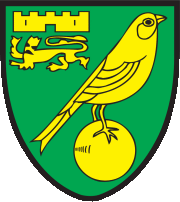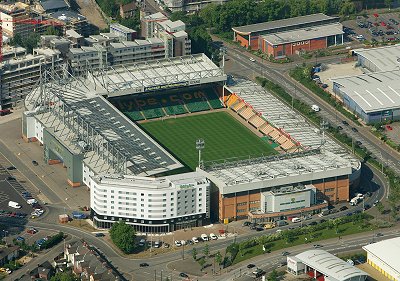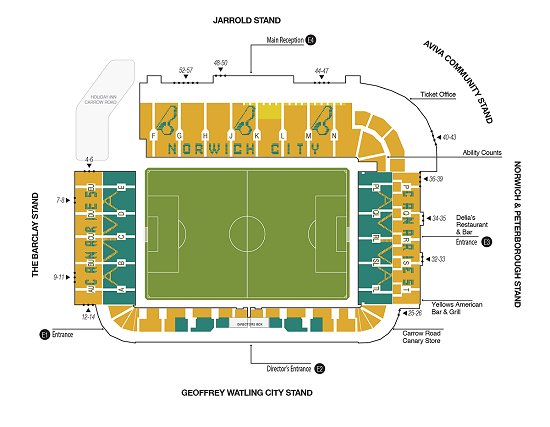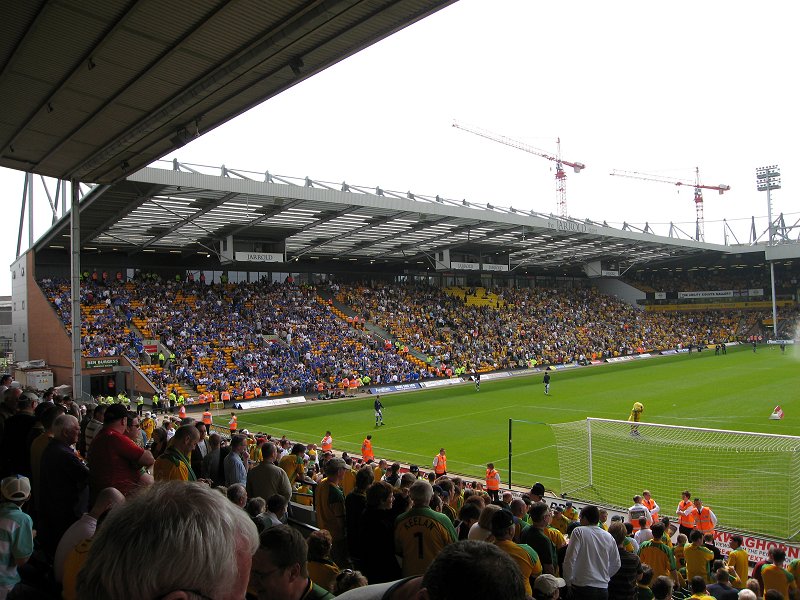
NORWICH CITY F.C.
Founded: 1902

CLICK ON THE MAP TO
VIEW ENLARGED MAP
|
NORWICH CITY F.C. (Football Club)
Included Info: Brief History, Club/Stadium Info, Team Jersey & Much More...
BRIEF HISTORY of NORWICH CITY FOOTBALL CLUB
(reproduced from 'Wikipedia' pages)
Norwich City F.C. was formed following a meeting at the Criterion Cafe in Norwich on 17 June 1902 and then
a sub meeting occurred on 2 July 1902 by a group of friends led by three former Norwich CEYMS players.
The club's original nickname was the Citizens, although this was superseded by 1907 by the more familiar
Canaries after the club's chairman (who was a keen breeder of canaries) dubbed his boys 'The Canaries'
and changing their strip to yellow and green. During the First World War, with football suspended and
facing spiralling debts, City went into voluntary liquidation on 10 December 1917. The club was officially
reformed on 15 February 1919. In May 1920, the Football League formed a third Division, Norwich joined the
Third Division for the following season. The club went on to endure a mediocre decade, finishing no higher
than eighth but no lower than 18th. The following decade proved more successful for the club with a
club-record victory, 10–2, over Coventry City and promotion as champions to the Second Division in the
1933–34 season. The club narrowly missed out on promotion under the guidance of manager Norman Low in the
early 1950s, but following the return of Tom Parker as manager, Norwich finished bottom of the football
league in the 1956–57 season. The 1958–59 season saw Norwich reach the semi-final of the FA Cup as a Third
Division side, defeating two First Division sides on the way: Tottenham Hotspur and Matt Busby's Manchester
United. In the 1959–60 season, Norwich were promoted to the Second Division after finishing second to
Southampton, and achieved a fourth place finish in the 1960–61 season.[14] In 1962 Ron Ashman guided Norwich
to their first trophy, defeating Rochdale 4–0 on aggregate in a two-legged final to win the League Cup.
Sixth place in the league was the closest the club came to promotion to the First Division during the 1960s,
but after winning the division in the 1971–72 season under manager Ron Saunders, Norwich City reached the
highest level of English football for the first time. They made their first appearance at Wembley Stadium
in 1973, losing the League Cup final 1–0 to Tottenham Hotspur. Relegation to the Second Division in 1974
resulted in the resignation of Saunders and the appointment of John Bond.[18] A highly successful first
season saw promotion back to the First Division and another visit to Wembley, again in the League Cup final,
this time losing 1–0 to Aston Villa. Bond resigned during the 1980–81 season and the club were relegated,
but bounced back the following season after finishing third. The 1984–85 season was of mixed fortunes for
the club; under Ken Brown's guidance, they reached the final of the Football League Cup at Wembley Stadium,
having defeated Ipswich Town in the semi-final. In the final, they beat Sunderland 1–0, but in the league
both Norwich and Sunderland were relegated to the second tier of English football. This made Norwich the
first English club to win a major trophy and suffer relegation in the same season; something which was not
matched until Birmingham City also suffered relegation the season they won the League Cup 26 years later.
During 1992–93, the inaugural season of the Premier League, Norwich City led the league for most of the
season, before faltering in the final weeks to finish third behind the champions, Manchester United, and
Aston Villa. The following season Norwich played in the UEFA Cup for the first time, losing in the third
round to Inter Milan, but defeating Bayern Munich. Winning 2–1, Norwich are the only British team to beat
Bayern Munich in the Olympic Stadium. The 2003–04 campaign saw the club win the First Division title,
finishing eight points clear of second-placed West Bromwich Albion and returned to the top flight for the
first time since 1995. For much of the 2004–05 season however, the club struggled and, despite beating
Manchester United 2–0 and Newcastle United 2–1 towards the end of the season, a last day 6–0 defeat away
to Fulham condemned them to relegation. On 18 August 2009, Paul Lambert was announced as the new manager,
leaving his post at Colchester, and nine months later led Norwich to promotion back to the Championship
as League One Champions, after a single season in League One. The following season saw Norwich promoted
to the Premier League, finishing second in the table behind QPR and completing the first back-to-back
promotions from the 3rd tier to the 1st since Manchester City in 2000. A generally successful season saw
the club finish in 12th place in their first season back in the Premier League.
|
CLUB FACTS & INFORMATION
| Official Name
| --
| Norwich City F.C. |
| Club Nickname
| --
| The Canaries |
| Year Founded
| --
| 1902 (115 years ago) |
| English County
| --
| Norfolk |
| Current Ground
| --
| Carrow Road |
| Ground Location
| --
| Norwich, England |
| Club's Owners
| --
| Delia Smith, Michael Wynn Jones |
| Club Chairman
| --
| Ed Balls |
| Current Manager
| --
| Daniel Farke |
| Current League
| --
| Championship |
| Last Season
| --
| Championship, 8th place |
HOME COLORS

Yellow & Green |
AWAY COLORS

Green & Yellow |
|
| |
INTERESTING STADIUM FACTS & INFORMATION

CARROW ROAD STADIUM
Carrow Road, Norwich, Norfolk, NR1-1JE, England
OPENED: ......... August 31, 1935
SURFACE: ........ Desso GrassMaster
COST: .............. not available
CAPACITY: ...... 27,244
RECORD: ......... 43,984 (1963 vs Leicester City)
OWNER: ........... Norwich City F.C.
OPERATOR: ..... Norwich City F.C.
FIELD SIZE: ..... 114 x 74 yards (104 x 68 meters)
|
|
|
HOME JERSEY
 |
AWAY JERSEY
 |

Click On Aerial Photo To View/Download Enlarged Image
|
Carrow Road (Norwich City) Seating Diagram
Click On Diagram Below To Enlarge View

|



NORWICH CITY STADIUM WALLPAPERS (Free Download)
Wallpaper Size below is 800x600: To Download Bigger Sizes, Click On Any Button Shown Above

|
|

